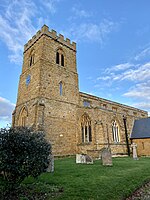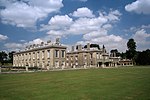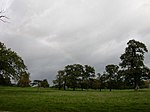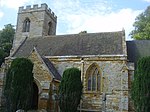Althorp (popularly pronounced AWL-thorp) is a Grade I listed stately home and estate in the civil parish of Althorp, in West Northamptonshire, England of about 13,000 acres (5,300 ha). By road it is about 6 miles (9.7 km) northwest of the county town of Northampton and about 75 miles (121 km) northwest of central London, situated between the villages of Great Brington and Harlestone. It has been held by the prominent aristocratic Spencer family for more than 500 years, and has been owned by Charles Spencer, 9th Earl Spencer since 1992. It was also the home of Lady Diana Spencer (later Princess of Wales) from her parents' divorce until her marriage to Charles, Prince of Wales (later King Charles III).
Althorp is mentioned as a small hamlet in the Domesday Book as "Olletorp", and by 1377 it had become a village with a population of more than fifty people. By 1505 there were no longer any tenants living there, and in 1508, John Spencer purchased Althorp estate with the funds generated from his family's sheep-rearing business. Althorp became one of the prominent stately homes in England. The house dates to 1688, replacing an earlier house that was once visited by Charles I. The Spencer family amassed an extensive art collection and other valuable household items. During the 18th century, the house became a major cultural hub in England, and parties were regularly held, attracting many prominent members of Great Britain's ruling class. George John, 2nd Earl Spencer, who owned Althorp between 1783 and his death in 1834, developed one of the largest private libraries in Europe at the palace, which grew to over 100,000 books by the 1830s. After falling on hard times, John Spencer, 5th Earl Spencer, known as the Red Earl, in 1892 sold much of the collection to Enriqueta Rylands, who was building the University of Manchester Library. Many of Althorp's furnishings were sold off during the twentieth century, and between 1975 and 1992 alone approximately 20% of the contents were auctioned.
The house at Althorp was a "classically beautiful" red brick Tudor building, but its appearance was radically altered, starting in 1788, when the architect Henry Holland was commissioned to make extensive changes. Mathematical tiles were added to the exterior, encasing the brick, and four Corinthian pilasters were added to the front. The grand hall entrance to the house, Wootton Hall, was cited by Sir Nikolaus Pevsner as "the noblest Georgian room in the county". The great dining room in the east wing extension of the house was added in 1877 to designs by John Macvicar Anderson, its walls hung with faded, red damask silk. Numerous fireplaces and furnishings were brought to Althorp from Spencer House in London during the Blitz for safekeeping and still remain. The Picture Gallery stretches for 115 feet (35 m) on the first floor of the west wing, and is one of the best remaining examples of the original Tudor oak woodwork and ambiance in the mansion. It has an extensive collection of portraits, including Anthony van Dyck's War and Peace, a John de Critz portrait of James I, a Mary Beale portrait of Charles II, and many others. Some £2 million was spent on redecorating the palace in the 1980s, during which time most of the religious paintings of Althorp were sold off.
In total, the grounds of Althorp estate contain 28 listed buildings and structures, including nine planting stones. The former falconry, now a Grade I listed building, was built in 1613. Gardener's House is listed as a Grade II* listed building in its own right, as are the Grade II listed West and East Lodges. The mustard-yellow Grade II listed stable block, designed by architect Roger Morris with a Palladian influence, was ordered by Charles, 5th Earl of Sunderland in the early 1730s. The French landscape architect André Le Nôtre was commissioned to lay out the park and grounds in the 1660s, and further alterations were made during the late 18th century under Henry Holland. Following the death of Diana, Princess of Wales in 1997, she was interred on a small island in the middle of the ornamental Round Oval lake. A Doric-style temple with Diana's name inscribed on top, situated across from the lake, is a tourist attraction during July and August when the house and estate are open to the public, although the exhibition centre, situated in the old stable block, closed permanently in 2013.







